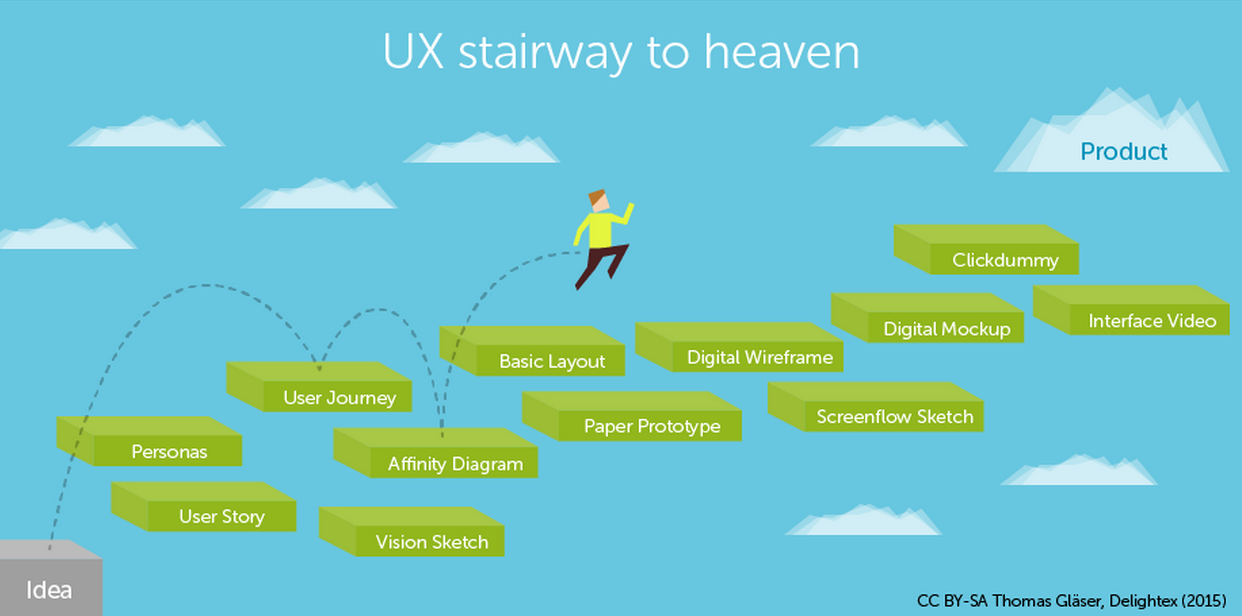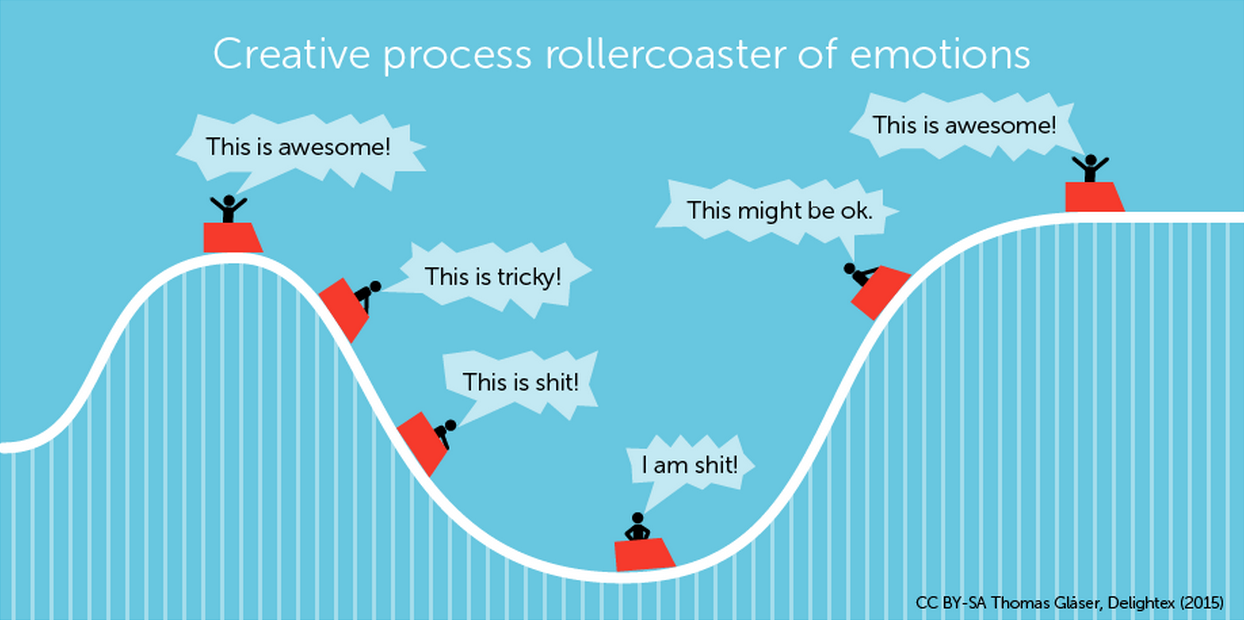UX Designers must not only create concepts and designs; they must also make the process of creation transparent and communicate the basics of UX design to all the projects’ participants. In my experience working on web projects over the last few years, I’ve observed that people tend to reach a point where they struggle to begin (or continue) with the next step, whether they’re moving from product idea to user stories, or from features to a user interface.
This is normal, especially in a field that essentially requires daily innovation. Common interactions like “Sign Up,” “Onboarding,” and “Check Out,” can apply functionality, interactions, or visual design from other solutions. In these cases, resources like UX Archive and UI Patterns can be a designer’s best friend. But what about the unique, challenging tasks? What about situations that require us to create intuitive methods and accomplish complex objectives?
In these unique cases, I’ve experienced that the temptation to stop when the going gets tough is always lurking around the corner. The fact is, it’s easy to become overwhelmed by the complexity of information or a problem.
The road from idea to solution is often slow, with many twists and turns. Luckily, there are research-based tactics that can help with navigating that road. In this article we’ll review a number of reasons we experience a loss of motivation, and ways to forge ahead.
Get started (and keep going)
Knowing how to get started, and actually getting started are very different things. Another obstacle to momentum might be not properly understanding the user, or not understanding and the need behind the task or interaction. This is basically like walking into a dark room only to fumble for the light switch.

The UX stairway to heaven. From idea to product we have a lot of possibilities to get closer to the product. But most of all, we have to get started and continue the creative process.
If there’s a lack of depth to the understanding, it’s essential to dig deeper. Get online, do some research about the audience. Observe them on social media. Get out of the building to interview potential users. Collect more data!
Of course, this can easily lead to another obstacle: information overload. One way to maneuver around information overload is to group, sort, and structure the collected information. Affinity diagrams can be a helpful method in this case. Combined with prioritization tools like MoSCoW Method or a Priority Matrix, we can better structure thoughts and make them more actionable.
Pick one fight at a time
The more complex the problem, the more likely it is to breed frustration. This is where strategy comes in. In the face of inherently limited energy, it’s crucial to be particular about where that energy is invested. I’ve seen designers try to tackle several design solutions at the same time, and almost without fail, they end up with unsatisfying results (or they just stop progressing).
For instance, when thinking about functionality, it’s probably not the right time to consider typefaces or button colors. We need to focus on the problem at hand: the functionality, and trust there will be time to come back to visuals after we’ve completed the interactions.
At the end of the day, this is a matter of design energy management. It’s just like how President Obama always wears the same suits—it’s a part of his secret strategy for staying productive. Too many decisions lead to what psychologists call a decision fatigue, which eventually leads to poor decisions, or none at all.
Postponing is bad
“I’ll do it tomorrow” may feel like the result of motivation loss, but in reality it can be part of the problem. We often postpone decisions that feel difficult, and thus fall into a procrastination trap. It’s not surprising; unpleasant decisions are harder to make. Cognitive psychology posits that we are far more likely to avoid an unpleasant task or decision.
There is a reason we all have tendencies to procrastinate when struggling. Predominantly, according to cognitive psychology, we tend to underestimate the future emotional state, based on what we feel right now. When I make a decision to do something in the future, I assume that it will be more comfortable in the future than it actually is. This has very serious implications for those of us involved in the design process.
If designers succumb to the satisfaction that accompanies postponing a task until a “more suitable tomorrow,” they may find that tomorrow never comes. Instead, learn to identify those thought patterns, and don’t let them lead the process astray.

The creative process rollercoaster of emotions. From excitement to frustration. Designing for a great user experience is a great experience itself.
No need for perfection
Perfectionism is a key obstacle to forward momentum. When describing this concept, I like to refer to this story of a ceramics teacher and his class. In this story, two teams had 50 pounds of clay and, out of that clay, they had to build pots. One team was to strive for quantity and build as many pots as possible, while the other team was told to focus on quality pots. In the end, perhaps surprisingly, the highest quality works were all produced by the quantity group.
It seems that while the quantity team was busily churning out piles of work and learning from their mistakes, the quality team sat theorizing about perfection, and in the end had little more to show for their efforts than grandiose theories and a pile of shapeless clay. Striving for perfection will not always push design forward. Especially in an early product phase. Done is better than perfect!
Reflect and improve, always improve
It’s extremely important to take some time for self reflection about the processes, particularly when we feel blocked in some way. Here are a few self-reflection questions I find helpful:
Am I trying to solve too many problems at the same time?
Do I have enough information to get started?
Is there some insecurity keeping me from moving forward?
Am I still trying to make it perfect from the beginning?
In addition, here are some great resources, to help UX designers improve their processes:
- Prototyping: A Practitioner’s Guide, by Todd Zaki Warfel, is a how-to guide to prototyping.
- Paper Prototyping: The Fast and Easy Way to Design and Refine User Interfaces, by Carolyn Snyder. This guide to paper prototyping explains in detail how to use paper prototypes for quick and valuable user research.
- Sketching User Experiences: Getting the Design Right and the Right Design, by Bill Buxton. This holistic approach to design thinking is a good starting point for designers struggling with motivation.
- Sketching User Experiences: The Workbook
- Austin Kleon on 10 Things Every Creative Person Should Remember But We Often Forget is taken from his book, and well worth five minutes of any designer’s day.
- Art & Fear: Observations On the Perils (and Rewards) of Artmaking, by David Bayles. As the title alludes to, this book investigates how art is made, and how fear stops so much art from being created.
- Solving the Procrastination Puzzle: A Concise Guide to Strategies for Change, by Timothy A Pychyl. This book is a helpful way to understand the reasons we tend to procrastinate, as well as ways to stop doing it.
- The Procrastination Equation Flowchart, a useful poster displaying procrastination variables and a handful of strategies to deal with it.
For readers who are currently struggling with the idea-to-product process, let’s connect! Send me an email, or comment down below!
Want to meet and connect with other designers? Come to push.conference in Munich on October 23 and 24, where Thomas will be organizing more amazing speakers. It’s a 2-day conference that unites 450 professionals from the UX field in order to exchange, learn and get inspired.